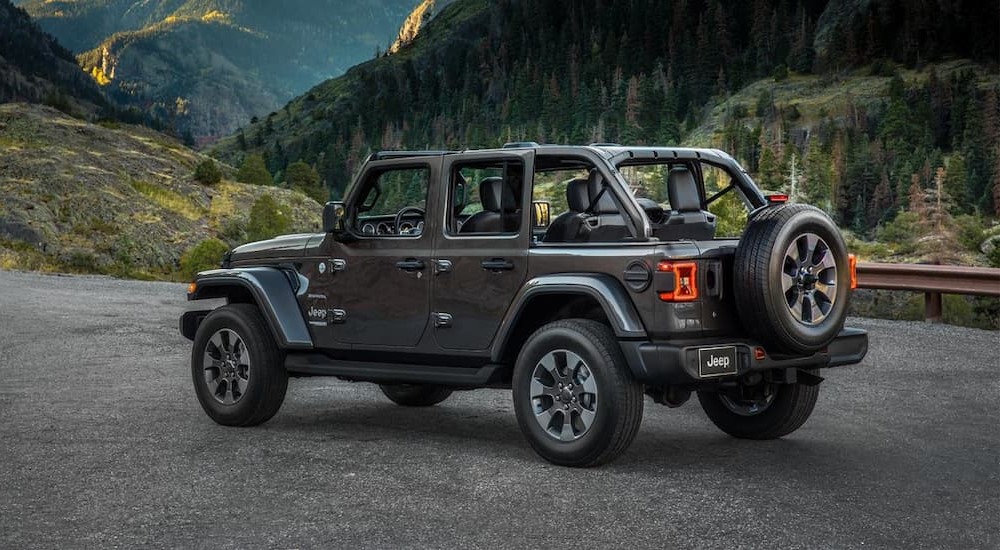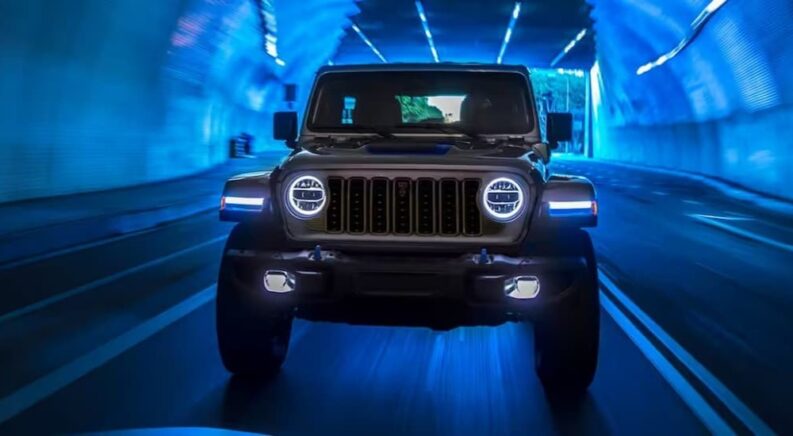As you search for hybrids and EVs for sale, you may encounter technological terms you’ve never heard before or which you’ve heard in ads or conversations without ever having anyone clearly define them for you. Many of these terms involve the hybrid systems in today’s cutting-edge vehicles. In particular, if you’ve been shopping for hybrid Jeep models, you might have come across the terms “eTorque” and “4xe” and wondered what the difference between them is. Aren’t they both hybrid drive systems? And if so, why does Jeep have two of them?
The basic explanation is this: eTorque is a simpler, “mild hybrid” system designed to boost power and fuel efficiency. By comparison, the 4xe (pronounced “four by E”) powertrain is a full-blown, “plug-in hybrid” system that allows a Jeep to run on pure electricity as well as a combination of gas and electricity. However, somewhat confusingly, both hybrid systems can be attached to the same 2.0L turbocharged gasoline engine.
eTorque can be found in a number of Jeep and Ram vehicles. For the 2023 model year, it can be found on Jeep Wrangler models equipped with the 3.6-litre Pentastar six-cylinder engine. It also resides under the hood of certain Ram 1500 models with the 5.7-litre HEMI V8. However, previous model years offered eTorque on a wider variety of models and engines. eTorque is more of an engine technology than a defining feature of a model.
By comparison, the 4xe plug-in hybrid powertrain is such a complete part of a vehicle’s identity that it’s designated as its own model lineup. If you look at the list of models on Jeep’s website, the Wrangler 4xe and the Grand Cherokee 4xe have their own sections. So, let’s take a look at the two hybrid drive systems and weigh the advantages of each.

The eTorque Mild Hybrid System
At its core, the eTorque system is a mild hybrid solution designed to enhance vehicle performance, efficiency, and driving experience. It combines a motor-generator unit with a dedicated 48-volt battery pack. This specialized system replaces the traditional alternator and works in tandem with the vehicle’s gasoline engine to offer numerous advantages.
eTorque Technical Specs
The eTorque system’s motor-generator unit plays a dual role: generating electricity and providing supplemental torque to the engine. When the engine is running, the motor generator feeds a 48V current to a dedicated lithium-ion battery. This battery isn’t just an energy reservoir. It houses a DC-to-DC converter to transform the 48V current to 12V power. This 12V output powers the Jeep Wrangler’s accessories and charges its standard 12V lead-acid battery.
But the eTorque system doesn’t stop there. The system harnesses energy that would typically go to waste. During deceleration and braking, the motor-generator unit captures energy, channelling it back to the 48V battery pack. This brake energy regeneration process not only ensures the battery remains charged but also enhances overall vehicle efficiency. In the 2023 Wrangler, opting for eTorque increases the estimated fuel economy from 11.8 L/100 km combined to 11.0 L/100 km combined.
Aesthetically, Jeep has ensured the eTorque’s battery pack is unobtrusive. The compact package is usually mounted to the rear of the cabin and hidden behind the second-row seats. The case is also well-insulated to dampen any noise from its cooling fans. Under the hood, the eTorque motor-generator unit is strategically positioned at the engine’s front, making maintenance simple.
The Benefits of eTorque
As we mentioned, the eTorque system contributes to vehicle efficiency. It’s adept at recapturing energy that would ordinarily be wasted. Moreover, vehicles equipped with the eTorque system boast impressive performance figures. In the Wrangler, the 3.6L Pentastar V6 engine with eTorque delivers 285 hp and 260 lb-ft of torque, with additional low-end torque compared to the non-eTorque version.
Beyond its power and efficiency, eTorque refines the driving experience. By delivering additional torque to the crankshaft during gear shifts, it reduces noise, vibration, and harshness (NVH), ensuring smoother rides. Plus, the eTorque system excels in its engine restart capability. It can send up to 90 lb-ft of torque to the engine crankshaft, restarting the engine within 400 milliseconds. This is over twice as swift as conventional starter motors and mitigates the delay upon startup that used to be a chief complaint about stop-start systems.
While the 48V battery pack is central to eTorque’s operations, the system still incorporates a traditional 12V battery. This inclusion offers two-fold benefits: greater efficiency in extreme temperatures, which is often an issue for electrified vehicles, and a simplified electrical system for powering 12-volt vehicle accessories.
The 4xe Plug-In Hybrid System
Jeep’s 4xe drive system marries the brand’s traditional off-road prowess with modern electric ingenuity. Central to the 4xe system is the sophisticated arrangement of a turbocharged inline-four engine paired with two electric motors. One motor is linked directly to the engine through the accessory belt, while a more powerful motor replaces the transmission’s torque converter. Powering these motors is a 17 kWh lithium-ion battery, discreetly positioned under the rear seats.
The entire system channels torque through an eight-speed automatic transmission. Being Jeep models, both the Wrangler 4xe and Grand Cherokee 4xe come standard with four-wheel drive. Plus, regenerative braking turns deceleration and braking into opportunities to recharge the battery. The driver-selectable Max Regeneration feature elevates this experience, allowing deceleration without frequent use of the brake pedal.
The results of this innovative setup are impressive. The 4xe system produces a combined output of 375 hp and 470 lb-ft of torque. Its efficiency metrics are equally commendable, with the 2024 Grand Cherokee 4xe rated for 4.2 Le/100 km combined when running on electricity. Running on the gasoline engine alone gets an estimated 10.0 L/100km combined, so you can see what an efficiency boost the electric components of the 4xe system provide.
Emissions-Free Driving
Jeep’s introduction of the 4xe system ensures that adventures are not just powerful but also quiet and green, especially when in Electric Mode. This silence, combined with zero tailpipe emissions at regular speeds, redefines the driving experience. Notably, drivers can indulge in an estimated 42 km of pure electric driving in the 2024 Grand Cherokee 4xe before the gasoline engine takes over. Moreover, the 4xe system is equipped with three customizable driving modes:
- Electric Mode: Prioritizes pure electric driving, providing dozens of kilometres of eco-friendly travel on a full charge.
- Hybrid Mode: A blend of the traditional 2.0L Turbo I-4 engine with the electric motors, ensuring optimal horsepower and instant torque. Here, electric power is consumed first, ensuring efficiency.
- eSave Mode: Focuses on utilizing the 2.0-litre engine while conserving battery power for later use. A unique feature allows it to increase battery charge when necessary.
Charging a 4xe model is hassle-free. With a Level 2 charger (240V), the battery reaches full capacity in about two hours. Alternatively, the included Level 1 charger (120V) takes approximately 12 hours. This flexibility ensures that short daily commutes can be fully electric, further pushing the boundaries of sustainable driving.
Which to Choose?
If you are trying to choose between an eTorque-equipped Jeep and a 4xe model, both offer advantages. The eTorque system is simpler and less expensive while still offering an efficiency boost and extra torque. The 4xe system is quite a bit more complicated and a bit on the pricey side, with the 2024 models starting at around $60,000 CAD, but it offers a much more sophisticated and fuel-efficient driving experience.
If you’re concerned about whether electrification compromises the essential capabilities of a Jeep, did we mention that the Wrangler 4xe offers 76 cm of water fording capability? Plus, the 4xe’s electric torque makes for excellent rock-crawling capabilities.
Ultimately, the decision may come down to personal preferences. Do you prefer the roar of a traditional gasoline engine under the hood, or does the idea of cruising along silently in Electric Mode on a beautiful summer day appeal to you? Either way, you can hardly go wrong. Happy trails, Jeep enthusiasts!




